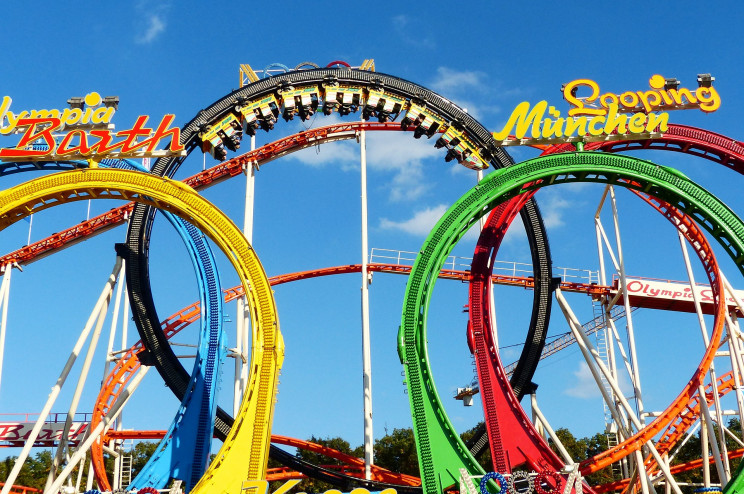How Is Trigonometry Used in Roller Coaster Designing
Do you want to design roller coasters? Are you tired of just playing Roller Coaster Tycoon and want to swap out the digital people riding your coasters for real ones? Well then, do we have the job for you! Get ready to become a real-life roller coaster engineer.
While the job title of roller coaster engineer might sound like a made-up job title on the list of a kid, it's actually a real career path, and it can be pretty exciting.
So, how do you become a roller coaster engineer?
How to become a roller coaster engineer
Every amusement park in the world needs a roller coaster engineer to design most of their attractions. Without the crucial work of an engineer's mind, there's nothing that would keep riders from just flying off the roller coaster at any moment. Generally, that should be avoided, which is why roller coaster engineers are crucial.

Formal education requirements
RC engineers will need to consider rider safety, as well as environmental safety, and even factor in "excitement" as a technical variable in their design. Most roller coaster engineers start their careers with a formal education in electrical, structural, or mechanical engineering. The perfect candidate would likely be proficient in all those disciplines.
Formal education requirements for roller coaster engineers are simply a bachelor's degree in these fields. However, in the U.S. at least, all roller coaster engineers have to obtain licensure in the form of a professional engineering certification, or P.E. This takes 4 years of relevant job experience and the passing of a final P.E. test.
RELATED: WHAT DO YOU NEED TO DO TO BECOME A THEME PARK ENGINEER
One thing to note is that the "relevant job experience" needed for the P.E. doesn't necessarily mean roller coaster design. Having some job experience relevant to working as an engineer would suffice.
The final keynote on education is that roller coaster engineering is a competitive field, meaning that a bachelor's degree likely won't set you apart from the field. While there are other less-expensive ways to differentiate yourself down the line, like job experience, getting a master's degree isn't a bad idea.
You might even consider writing your thesis for your master's program on something roller-coaster-specific to really demonstrate your knowledge and interest in the field.
Job potential and salary
As for job potential, demand for roller coasters and the engineers that design them is obviously dependent on the economic progress and stability. Since theme parks and roller coasters fill the entertainment niche in society, it relies on whether consumers have excess income to spend on activities. However, with global economies generally being in a good state at the moment, current demand is expected to grow 4% over the next decade.
As for what you can expect to make once you start designing roller coasters? Roughly $92,800 USD per year, which is roughly on par with average P.E. mechanical engineering salaries in the US.
Day to day life as a roller coaster engineer
Roller coaster engineers will work on a design team for each project, often either as a contractor or as part of a larger roller coaster design agency. Your main job description will involve determining how to build a given track, where to place the supports, developing the control and safety systems, and ensuring the safety of the final ride.
You'll also have to engage some creativity in the design to ensure that the final ride is actually exciting for the passengers. Since you won't actually be able to experience the ride until it's completed, you'll need to conceptually understand what makes roller coasters fun.
This usually involves knowing where to place loops on the track and how to lay out the natural scenery to create a good overall experience.
The design teams you will work on as a roller coaster engineer will have engineers from multiple disciplines, all usually in the structural, electronic, and mechanical fields. Depending upon the project budget, you might have to work in different disciplines or roles on the team as well. Meaning that there might not always be enough budget to hire an independent electrical engineer and mechanical engineer and that one person might have to do the role of both.
Safety is the biggest factor in the entire design process. If the final design isn't safe, well, then the entire project has to be scrapped. You'll have to accurately model the final coasters speed, weight, and forces, all before it's ever built to ensure that no one's limbs are ripped off or you're not building a roller coaster of certain death, as explained in the video below.
At the end of the day, becoming a roller coaster engineer can be one of the most exciting and rewarding engineering professions. While many engineers spend their days designing HVAC systems or bridges, when you complete a project as a roller coaster engineer, you get to actually experience the thrills of your hard work. Sure, driving across a bridge you helped design is fun, but I'd argue doing a double looped hyper twist while in a car that looks like a rocket is probably just a little more fun, and maybe a little bit more rewarding... but we'll leave it up to the roller coaster engineers to determine that one.
How Is Trigonometry Used in Roller Coaster Designing
Source: https://interestingengineering.com/which-engineering-degree-do-you-need-to-design-roller-coasters
0 Response to "How Is Trigonometry Used in Roller Coaster Designing"
Post a Comment